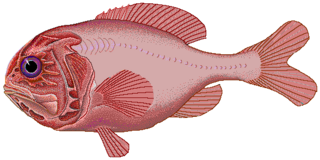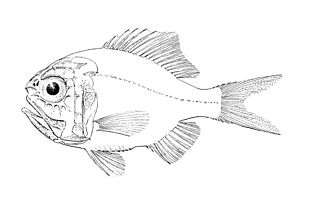
The Beryciformes are a poorly-understood order of carnivorous ray-finned fishes consisting of 7 families, 30 genera, and 161 species. They feed on small fish and invertebrates. Beyond this, little is known about the biology of most member species because of their nocturnal habits and deepwater habitats. All beryciform species are marine and most live in tropical to temperate, deepwater environments. Most live on the continental shelf and continental slope, with some species being found as deep as 2,000 m (6,600 ft). Some species move closer to the surface at night, while others live entirely in shallow water and are nocturnal, hiding in rock crevices and caves during the day. Several species are mesopelagic and bathypelagic. Beryciformes' bodies are deep and mildly compressed, typically with large eyes that help them see in darker waters. Colors range from red to yellow and brown to black, and sizes range from 8–61 cm (3.1–24.0 in). Member genera include the alfonsinos, squirrelfishes, flashlight fishes, fangtooth fishes, spinyfins, pineconefishes, redfishes, roughies, and slimeheads. A number of member species are caught commercially, including the alfonsino, the splendid alfonsino, and the orange roughy, the latter being much more economically important. Some species have bioluminescent bacteria contained in pockets of skin or in light organs near the eyes, including the anomalopids and monocentrids.

The orange roughy, also known as the red roughy, slimehead and deep sea perch, is a relatively large deep-sea fish belonging to the slimehead family (Trachichthyidae). The UK Marine Conservation Society has categorized orange roughy as "vulnerable to exploitation". It is found in 3 to 9 °C, deep waters of the Western Pacific Ocean, eastern Atlantic Ocean, Indo-Pacific, and in the eastern Pacific off Chile. The orange roughy is notable for its extraordinary lifespan, attaining over 200 years. It is important to commercial deep-trawl fisheries. The fish is a bright, brick-red color, fading to a yellowish-orange after death.

Slimeheads, also known as roughies and redfish, are mostly small, exceptionally long-lived, deep-sea beryciform fish constituting the family Trachichthyidae. Found in temperate to tropical waters of the Atlantic, Indian, and Pacific Oceans, the family comprises about 50 species in eight genera. Slimeheads are named for the network of muciferous canals riddling their heads.

Demersal fish, also known as groundfish, live and feed on or near the bottom of seas or lakes. They occupy the sea floors and lake beds, which usually consist of mud, sand, gravel or rocks. In coastal waters they are found on or near the continental shelf, and in deep waters they are found on or near the continental slope or along the continental rise. They are not generally found in the deepest waters, such as abyssal depths or on the abyssal plain, but they can be found around seamounts and islands. The word demersal comes from the Latin demergere, which means to sink.

The silver roughy or Mediterranean slimehead is a small deep-sea fish species belonging to the slimehead family (Trachichthyidae). It is found widely at depths of 100 to 1,175 m (328–3,855 ft) in the Atlantic, ranging from Iceland and Georges Bank in the north to South Africa and Brazil in the south, including the Mediterranean and Gulf of Mexico. It is also found in the Western Indian Ocean, including the Red Sea.

Hoplostethus is a genus of fish in the slimehead family.
Hoplostethus tenebricus is a small deep-sea fish species belonging to the slimehead family (Trachichthyidae).
Hoplostethus rubellopterus, is a small deep-sea fish species belonging to the slimehead family (Trachichthyidae).
Hoplostethus fedorovi is a small deep-sea fish species belonging to the slimehead family (Trachichthyidae).

The giant sawbelly is a medium-sized deep-sea fish species belonging to the slimehead family (Trachichthyidae). It is found along the western and southern coasts of Australia and near New Zealand. It lives on the continental slope between depths of 237 and 311 metres. It can reach sizes of up to 52.5 centimetres (20.7 in) SL.

The blacktip sawbelly is a small deep-sea fish species belonging to the slimehead family (Trachichthyidae). It is found off southern Australia and New Zealand. It ranges at depths from 200 to 680 metres where it lives on the continental shelf and continental slope. It can reach sizes of up to 18.0 centimetres (7.1 in).

The palefin sawbelly is a medium-sized deep-sea fish species belonging to the slimehead family. It is native to Australia's southern waters and the Eastern Indian Ocean where it lives at depths between 146 and 586 metres on the continental slope and continental shelf. It can reach sizes of up to 53.0 centimetres (20.9 in) TL.
Hoplostethus abramovi is a slimehead belonging to the family Trachichthyidae. It is native to northern Madagascar in the west Indian Ocean and lives in deep water up to 300 metres (980 ft) below the surface. It can reach a maximum length of 19 centimetres (7.5 in).
The black slimehead is a member of the order Beryciformes. It is found along the coast of northwest Africa from Cape Verde down to South Africa. It typically lives near the ocean floor 200–700 m (660–2,300 ft) deep, but can be found up ranging from 70–1,000 m (230–3,280 ft) deep. It can reach lengths of up to 30 cm (12 in).
Hoplostethus confinis is a species of slimehead native to the Andaman Sea in the Indian Ocean. It lives in deep water between 290m and 330m from the surface and can reach sizes of up to 12.3 cm.
Hoplostethus druzhinini is a species of slimehead native to the western Indian Ocean off the coast of Yemen. It lives in deep water between 330m and 445m and can reach sizes of up to 13.1 cm.
The New Zealand giant sawbelly is a slimehead of the order Beryciformes. It is native to the South Pacific, more specifically the sub-tropical and temperate latitudes of the Tasman and South Fiji basins. It is also found along Australia's southeastern coast, the Bay of Plenty, and southern Kermadec Ridge at the north end of New Zealand's North Island. It can reach sizes of up to 51.5 cm (20.3 in) SL. Its natural habitats are "continental slopes, seamounts, and submarine rises" between 250–400 m (820–1,310 ft), though it has been found as shallow as 140 metres (460 ft) and as deep as 760 m (2,490 ft). The first H. melanopeza caught were thought to be individuals of the H. gigas species, and it was not distinguished as a separate species until much later. One key difference between the two is that although both are red, H. melanopeza has black fin margins.
The blackfin roughy is a slimehead of the order Beryciformes. It has a very wide distribution across the Atlantic, Pacific, and Indian Oceans. It can reach sizes of up to 14.0 cm (5.5 in) TL. It is a deepwater fish, living between 454–1,500 m (1,490–4,921 ft) deep.
The metallic roughy is a slimehead of the order Beryciformes. It is native to the Western Central Pacific along the eastern seaboard of Negros Island in the Philippines and other locations in the Sulu Sea. It has a deep-water range of 55–550 m (180–1,804 ft). It is known from only 25 collected specimens, but members of this genus are known to frequently be "locally abundant," occurring in dense schools over seamounts.
Hoplostethus mikhailini is a deepwater species of the family Trachichthyidae. It is native to the Southeast Atlantic and Western Indian Ocean from the Cape of Good Hope to Delagoa Bay where it lives as depths ranging from 273 to 525 metres. It can reach sizes of up to 14.7 centimetres (5.8 in) SL.








